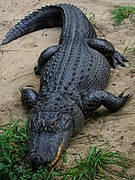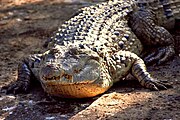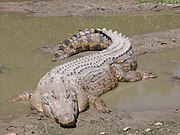List of crocodilians
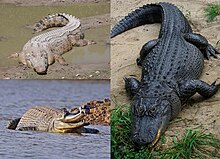
Crocodilia is an order of mostly large, predatory, semiaquatic reptiles, which includes true crocodiles, the alligators and caimans, and the gharial and false gharial. A member of this order is called a crocodilian, or colloquially a crocodile.
The 9 genera and 28 species of Crocodilia are split into 3 subfamilies: Alligatoridae, alligators and caimans; Crocodylidae, true crocodiles; and Gavialidae, the gharial and false gharial.
Conventions
| Conservation status | |
|---|---|
| EX | Extinct (0 species) |
| EW | Extinct in the wild (0 species) |
| CR | Critically Endangered (7 species) |
| EN | Endangered (0 species) |
| VU | Vulnerable (4 species) |
| NT | Near threatened (0 species) |
| LC | Least concern (12 species) |
| Other categories | |
| DD | Data deficient (0 species) |
| NE | Not evaluated (5 species) |
Conservation status codes listed follow the International Union for Conservation of Nature (IUCN) Red List of Threatened Species. Range maps are provided wherever possible; if a range map is not available, a description of the crocodilian's range is provided. Ranges are based on the IUCN red list for that species unless otherwise noted. All extinct species or subspecies listed alongside extant species went extinct after 1500 CE, and are indicated by a dagger symbol "†". Population figures are rounded to the nearest hundred.
Classification
The order Crocodilia consists of 28 extant species belonging to 9 genera. This does not include hybrid species or extinct prehistoric species. Modern molecular studies indicate that the 9 genera can be grouped into 3 families.
Family Alligatoridae (Alligators and caimans)
- Genus Alligator: two species
- Genus Caiman: three species
- Genus Melanosuchus: one species
- Genus Paleosuchus: two species
Family Crocodylidae (True crocodiles)
- Genus Crocodylus: fourteen species
- Genus Mecistops: two species
- Genus Osteolaemus: two species
Family Gavialidae (Gharial and false gharial)
Crocodilians
Family Alligatoridae
The extant Alligatoridae can be recognised by the broad snout, in which the fourth tooth of the lower jaw cannot be seen when the mouth is closed.[1]
| Common name | Scientific name and subspecies | Range | Size and ecology | IUCN status and estimated population |
|---|---|---|---|---|
| American alligator | A. mississippiensis Daudin, 1801 |
Southeastern United States
|
Size: up to 450 kg (990 lb) Habitat: Wetlands (inland), intertidal marine, and coastal marine[2] Diet: [2] |
LC
|
| Chinese alligator | A. sinensis Fauvel, 1879 |
Eastern China
|
Size: up to 45 kg (99 lb) Habitat: Inland wetlands[3] Diet: [3] |
CR
|
| Common name | Scientific name and subspecies | Range | Size and ecology | IUCN status and estimated population |
|---|---|---|---|---|
| Spectacled caiman | C. crocodilus Linnaeus, 1758 |
Northern South America and Central America
|
Size: up to 45 kg (99 lb) Habitat: Forest, savanna, shrubland, grassland, and inland wetlands[4] Diet: [4] |
LC
|
| Broad-snouted caiman | C. latirostris Daudin, 1802 |
Southeastern South America
|
Size: up to 50 kg (110 lb) Habitat: Inland wetlands and intertidal marine[5] Diet: [5] |
LC
|
| Yacare caiman | C. yacare Daudin, 1802 |
Central and southern South America
|
Size: up to 60 kg (130 lb) Habitat: Inland wetlands[6] Diet: [6] |
LC
|
| Common name | Scientific name and subspecies | Range | Size and ecology | IUCN status and estimated population |
|---|---|---|---|---|
| Black caiman | M. niger Spix, 1825 |
Northern South America
|
Size: up to 500 kg (1,100 lb) Habitat: [7] Diet: [7] |
LC
|
| Common name | Scientific name and subspecies | Range | Size and ecology | IUCN status and estimated population |
|---|---|---|---|---|
| Cuvier's dwarf caiman | P. palpebrosus Cuvier, 1807 |
Northern and central South America
|
Size: typically 6–7 kg (13–15 lb) Habitat: Inland wetlands[8] Diet: [8] |
LC
|
| Smooth-fronted caiman | P. trigonatus Schneider, 1801 |
Northern South America
|
Size: typically 9–20 kg (20–44 lb) Habitat: Forest and inland wetlands[9] Diet: [9] |
LC
|
Family Crocodylidae
The extant Crocodylidae have a variety of snout shapes, but can be recognised because the fourth tooth of the lower jaw is visible when the mouth is closed.[1]
| Common name | Scientific name and subspecies | Range | Size and ecology | IUCN status and estimated population |
|---|---|---|---|---|
| American crocodile | C. acutus Cuvier, 1807 |
Northern South America, Central America, Greater Antilles
|
Size: up to 500 kg (1,100 lb) Habitat: Forest, neritic marine, intertidal marine, and coastal marine[10] Diet: [10] |
VU
|
| Hall's New Guinea crocodile
|
C. halli Murray, Russo, Zorrilla, McMahan, |
New Guinea | Size: up to 3.5 m (11 ft) for males and 2.7 m (8.9 ft) for females Habitat: Swamps, rivers, and lakes Diet: |
NE
|
| Orinoco crocodile | C. intermedius Graves, 1819 |
Northern South America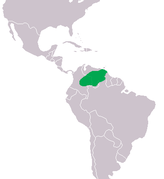
|
Size: up to 635 kg (1,400 lb) Habitat: Forest, savanna, and inland wetlands[11] Diet: [11] |
CR
|
| Freshwater crocodile | C. johnstoni Krefft, 1873 |
Northern Australia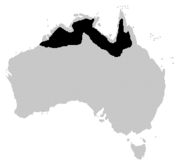
|
Size: up to 100 kg (220 lb) Habitat: Inland wetlands[12] Diet: [12] |
LC
|
| Philippine crocodile | C. mindorensis Schmidt, 1935 |
Philippines |
Size: up to 90 kg (200 lb) Habitat: Inland wetlands[13] Diet: [13] |
CR
|
| Morelet's crocodile | C. moreletii Duméril, 1851 |
Eastern Mexico
|
Size: up to 150 kg (330 lb) Habitat: Inland wetlands[14] Diet: [14] |
LC
|
| Nile crocodile | C. niloticus Laurenti, 1768 |
Sub-Saharan Africa
|
Size: up to 750 kg (1,650 lb) Habitat: Inland wetlands, neritic marine, intertidal marine, and coastal marine[15] Diet: [15] |
LC
|
| New Guinea crocodile | C. novaeguineae Schmidt, 1928 |
New Guinea
|
Size: up to 200 kg (440 lb) Habitat: Inland wetlands[16] Diet: [16] |
LC
|
| Mugger crocodile | C. palustris Lesson, 1831 |
Southern Asia
|
Size: up to 400 kg (880 lb) Habitat: Inland wetlands and neritic marine[17] Diet: [17] |
VU
|
| Saltwater crocodile | C. porosus Schneider, 1801 |
South and Southeast Asia, northern Australia and Oceania
|
Size: up to 1,000 kg (2,200 lb) Habitat: [18] Diet: [18] |
LC
|
| Borneo crocodile
|
C. raninus Müller, 1844 |
Borneo | Size: Habitat: Diet: |
NE
|
| Cuban crocodile | C. rhombifer Cuvier, 1807 |
Cuba
|
Size: up to 215 kg (474 lb) Habitat: Inland wetlands[19] Diet: [19] |
CR
|
| Siamese crocodile | C. siamensis Schneider, 1801 |
Southeast Asia
|
Size: up to 120 kg (260 lb) Habitat: Inland wetlands[20] Diet: [20] |
CR
|
| West African crocodile | C. suchus Geoffroy, 1807 |
Western and central Africa | Size: Habitat: Diet: |
NE
|
| Common name | Scientific name and subspecies | Range | Size and ecology | IUCN status and estimated population |
|---|---|---|---|---|
| West African slender-snouted crocodile | M. cataphractus F. Cuvier, 1825 |
Western Africa | Size: up to 325 kg (717 lb) Habitat: Forest, savanna, inland wetlands, neritic marine, and coastal marine[21] Diet: [21] |
CR
|
| Central African slender-snouted crocodile | M. leptorhynchus Bennett, 1835 |
Central Africa | Size: Habitat: Diet: |
NE
|
| Common name | Scientific name and subspecies | Range | Size and ecology | IUCN status and estimated population |
|---|---|---|---|---|
| Osborn's dwarf crocodile | O. osborni Schmidt, 1919 |
Congo Basin | Size: Habitat: Diet: |
NE
|
| Dwarf crocodile | O. tetraspis Cope, 1861 |
Western Africa
|
Size: Habitat: [22] Diet: [22] |
VU
|
Family Gavialidae
Gavialidae can be recognised by the long narrow snout, with an enlarged boss at the tip.[1]
| Common name | Scientific name and subspecies | Range | Size and ecology | IUCN status and estimated population |
|---|---|---|---|---|
| Gharial | G. gangeticus Gmelin, 1789 |
Scattered south Asia
|
Size: up to 680 kg (1,500 lb) Habitat: Wetlands (inland)[23] Diet: [23] |
CR
|
| Common name | Scientific name and subspecies | Range | Size and ecology | IUCN status and estimated population |
|---|---|---|---|---|
| False gharial | T. schlegelii Müller, 1838 |
Southeast Asia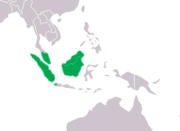
|
Size: up to 270 kg (600 lb) Habitat: Forest and inland wetlands[24] Diet: [24] |
VU
|
References
- ^ a b c Lang, J. W. (2002). "Crocodilians". In Halliday, T.; Adler, K. (eds.). The Firefly Encyclopedia of Reptiles and Amphibians. Firefly Books. pp. 212–221. ISBN 978-1-55297-613-5.
- ^ a b c Elsey, R.; Woodward, A.; Balaguera-Reina, S. A. (2019). "Alligator mississippiensis". IUCN Red List of Threatened Species. 2019: e.T46583A3009637. doi:10.2305/IUCN.UK.2019-2.RLTS.T46583A3009637.en.
- ^ a b c Jiang, H.; Wu, X. (2018). "Alligator sinensis". IUCN Red List of Threatened Species. 2018: e.T867A3146005. doi:10.2305/IUCN.UK.2018-1.RLTS.T867A3146005.en.
- ^ a b c Balaguera-Reina, S. A.; Velasco, A. (2019). "Caiman crocodilus". IUCN Red List of Threatened Species. 2019: e.T46584A3009688. doi:10.2305/IUCN.UK.2019-1.RLTS.T46584A3009688.en.
- ^ a b c Siroski, P.; Bassetti, L. A. B.; Piña, C.; Larriera, A. (2020). "Caiman latirostris". IUCN Red List of Threatened Species. 2020: e.T46585A3009813. doi:10.2305/IUCN.UK.2020-3.RLTS.T46585A3009813.en.
- ^ a b c Campos, Z.; Llobet, A.; Magnusson, W. E.; Piña, C. (2020). "Caiman yacare". IUCN Red List of Threatened Species. 2020: e.T46586A3009881. doi:10.2305/IUCN.UK.2020-3.RLTS.T46586A3009881.en.
- ^ a b c Ross, J. P. (2000). "Melanosuchus niger". IUCN Red List of Threatened Species. 2000: e.T13053A3407604. doi:10.2305/IUCN.UK.2000.RLTS.T13053A3407604.en.
- ^ a b c Magnusson, W. E.; Campos, Z.; Muniz, F. (2019). "Paleosuchus palpebrosus". IUCN Red List of Threatened Species. 2019: e.T46587A3009946. doi:10.2305/IUCN.UK.2019-1.RLTS.T46587A3009946.en.
- ^ a b c Campos, Z.; Magnusson, W. E.; Muniz, F. (2019). "Paleosuchus trigonatus". IUCN Red List of Threatened Species. 2019: e.T46588A3010035. doi:10.2305/IUCN.UK.2019-1.RLTS.T46588A3010035.en.
- ^ a b c Ponce-Campos, P.; Thorbjarnarson, J.; Velasco, A. (IUCN SSC Crocodile Specialist Group). (2012). "Crocodylus acutus". IUCN Red List of Threatened Species. 2012: e.T5659A3043244. doi:10.2305/IUCN.UK.2012.RLTS.T5659A3043244.en.
- ^ a b c Balaguera-Reina, S. A.; Espinosa-Blanco, A.; Antelo, R.; Morales-Betancourt, M.; Seijas, A. (2020) [errata version of 2018 assessment]. "Crocodylus intermedius". IUCN Red List of Threatened Species. 2018: e.T5661A181089024. doi:10.2305/IUCN.UK.2018-1.RLTS.T5661A181089024.en.
- ^ a b c Isberg, S.; Balaguera-Reina, S. A.; Ross, J. P. (2017). "Crocodylus johnstoni". IUCN Red List of Threatened Species. 2017: e.T46589A3010118. doi:10.2305/IUCN.UK.2017-3.RLTS.T46589A3010118.en.
- ^ a b c van Weerd, M.; C. Pomaro, C.; de Leon, J.; Antolin, R.; Mercado, V. (2016). "Crocodylus mindorensis". IUCN Red List of Threatened Species. 2016: e.T5672A3048281. doi:10.2305/IUCN.UK.2016-3.RLTS.T5672A3048281.en.
- ^ a b c Cedeño-Vázquez, J. R.; Platt, S. G.; Thorbjarnarson, J. (IUCN Crocodile Specialist Group). (2012). "Crocodylus moreletii". IUCN Red List of Threatened Species. 2012: e.T5663A3045579. doi:10.2305/IUCN.UK.2012.RLTS.T5663A3045579.en.
- ^ a b c Isberg, S.; Combrink, X.; Lippai, C.; Balaguera-Reina, S. A. (2019). "Crocodylus niloticus". IUCN Red List of Threatened Species. 2019: e.T45433088A3010181. doi:10.2305/IUCN.UK.2019-1.RLTS.T45433088A3010181.en.
- ^ a b c Solmu, G.; Manolis, C. (2019). "Crocodylus novaeguineae". IUCN Red List of Threatened Species. 2019: e.T46591A3010398. doi:10.2305/IUCN.UK.2019-2.RLTS.T46591A3010398.en.
- ^ a b c Choudhury, B. C.; de Silva, A. (2013). "Crocodylus palustris". IUCN Red List of Threatened Species. 2013: e.T5667A3046723. doi:10.2305/IUCN.UK.2013-2.RLTS.T5667A3046723.en.
- ^ a b c Crocodile Specialist Group (1996). "Crocodylus porosus". IUCN Red List of Threatened Species. 1996: e.T5668A11503588. doi:10.2305/IUCN.UK.1996.RLTS.T5668A11503588.en.
- ^ a b c Targarona, R. R.; Soberón, R. R.; Cotayo, L.; Tabet, M. A.; Thorbjarnarson, J. (2017) [errata version of 2008 assessment]. "Crocodylus rhombifer". IUCN Red List of Threatened Species. 2008: e.T5670A11516438. doi:10.2305/IUCN.UK.1996.RLTS.T5670A11516438.en.
- ^ a b c Bezuijen, M.; Simpson, B.; Behler, N.; Daltry, J.; Tempsiripong, Y. (2012). "Crocodylus siamensis". IUCN Red List of Threatened Species. 2012: e.T5671A3048087. doi:10.2305/IUCN.UK.2012.RLTS.T5671A3048087.en.
- ^ a b c Shirley, M. H. (2014). "Mecistops cataphractus". IUCN Red List of Threatened Species. 2014: e.T5660A3044332. doi:10.2305/IUCN.UK.2014-1.RLTS.T5660A3044332.en.
- ^ a b c Crocodile Specialist Group (1996). "Osteolaemus tetraspis". IUCN Red List of Threatened Species. 1996: e.T15635A4931429. doi:10.2305/IUCN.UK.1996.RLTS.T15635A4931429.en.
- ^ a b c Lang, J; Chowfin, S.; Ross, J. P. (2019) [errata version of 2019 assessment]. "Gavialis gangeticus". IUCN Red List of Threatened Species. 2019: e.T8966A149227430. doi:10.2305/IUCN.UK.2019-1.RLTS.T8966A149227430.en.
- ^ a b c Bezuijen, M. R.; Shwedick, B.; Simpson, B. K.; Staniewicz, A.; Stuebing, R. (2014). "Tomistoma schlegelii". IUCN Red List of Threatened Species. 2014: e.T21981A2780499. doi:10.2305/IUCN.UK.2014-1.RLTS.T21981A2780499.en.

